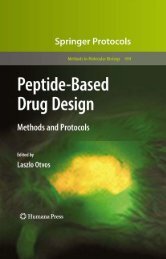Create successful ePaper yourself
Turn your PDF publications into a flip-book with our unique Google optimized e-Paper software.
224 Cudic and Stawikowski<br />
widely considered as lead compounds in drug development, and at present<br />
peptide-based therapeutics exists for a wide variety of human diseases, including<br />
osteoporosis (calcitonin), diabetes (insulin), infertility (gonadorelin), carcinoid<br />
tumors and acromegaly (octreotide), hypothyroidism (thyrotropin-releasing<br />
hormone [TRH]), and bacterial infections (vancomycin, daptomycin) (2).<br />
However, despite the great potential, there are still some limitations for peptides<br />
as drugs per se. Major disadvantages are short half-life, rapid metabolism, and<br />
poor oral bioavailability. Nevertheless, pharmacokinetic properties of peptides<br />
can be improved by different types of modifications (2,3). Peptidomimetic<br />
modifications or cyclization of linear peptides are frequently used as attractive<br />
methods to provide more conformationally constrained and thus more stable<br />
bioactive peptides (4–11). Among numerous peptidomimetic approaches used<br />
for the design and synthesis of peptide analogues with improved pharmacological<br />
properties, pseudopeptides or peptide bond surrogates, in which peptide<br />
bonds have been replaced with other chemical groups, are especially attractive.<br />
This is mainly because such approaches create amide bond surrogates with<br />
defined three-dimensional structures similar to those of natural peptides, yet with<br />
significant differences in polarity, hydrogen bonding capability, and acid-base<br />
character. Also importantly, the structural and stereochemical integrities of the<br />
adjacent pair of α-carbon atoms in these pseudopeptides are unchanged. The psibracket<br />
(�[ ]) nomenclature is used for this type of modifications (12). The introduction<br />
of such modifications to the peptide sequence is expected to completely<br />
prevent protease cleavage of amide bond and significantly improve peptides’<br />
methabolic stability. But besides these positive effects, such modifications may<br />
also have some negative effects on peptides’ biophysical and biochemical<br />
properties, in particular their conformation, flexibility, and hydrophobicity.<br />
Therefore, the choice of an amide bond surrogate is a compromise between<br />
positive effects on pharmacokinetics and bioavailability and potential negative<br />
effects on activity and specificity. In particular, the conservation of the stereochemistry<br />
of the parent peptide should be an important criterion in selection of<br />
the surrogate. The ability of the surrogate to mimic the steric, electronic, and<br />
solvation properties of the amide bond is certainly the most important characteristic<br />
determining the potency of pseudopeptide analogs.<br />
In this chapter we consider the synthesis of peptide analogs containing<br />
the amide surrogate that tend to be isosteric with the natural amide. This<br />
includes synthesis of peptidosulfonamides, phosphonopeptides, oligoureas,<br />
depsides, depsipeptides, peptoids, and peptomers (Fig. 1). Given the importance<br />
of peptides as lead compounds for drug discovery and development,<br />
it is not surprising that the above-mentioned peptidomimetic strategies to<br />
enhance peptide stability have attracted a great deal of attention in the last few<br />
decades (2,11).






